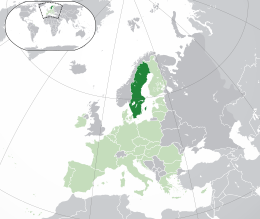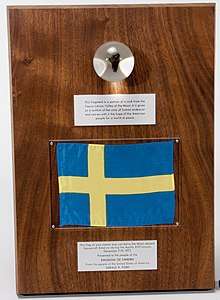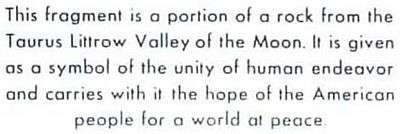Sweden lunar sample displays
The Sweden goodwill lunar displays are two commemorative plaques consisting of tiny fragments of Moon specimens brought back with the Apollo 11 and Apollo 17 lunar missions. These plaques were given to the people of Sweden by United States President Richard Nixon as goodwill gifts.[1][2]

Description
Apollo 11
The Sweden Apollo 11 lunar sample display commemorative podium style plaque consists of four "Moon rock" rice-size particle specimens that were collected by Apollo 11 astronauts Neil Armstrong and Buzz Aldrin in 1969 and a small Swedish flag that was taken to the Moon and back on Apollo 11.[1]
The four "Moon rocks" weigh about 0.05 grams in total. They are encased in a clear plastic button the size of a coin which is mounted to a wooden board approximately one foot square on a small podium pedestal display. The small podium plaque display also has mounted on it a small Sweden nylon country flag (4 inches by 6 inches) that was taken to the Moon and back, which lies directly below the "goodwill Moon rocks". The small podium plaque display was given to the people of the country of Sweden as a gift by President Richard Nixon. Similar lunar sample displays were also distributed to all the states of the United States and all the countries of the world.[1]
Apollo 17


The Sweden Apollo 17 lunar sample display commemorative style plaque (10 by 14 inches) consists of one "Moon rock" particle specimen that was cut from lunar basalt 70017 and placed in a clear plastic ball. The lunar basalt 70017 was collected by Apollo 17 astronaut Harrison Schmitt on the Moon in 1972. Once lunar basalt 70017 was brought back to Earth from the Moon, the basalt Moon rock was cut up into small fragments of approximately 1 gram. The specimen was encased in a plastic ball and mounted on the wooden plaque along with the Swedish flag, which had been taken to the Moon and back by the crew of Apollo 17. The plaque was then distributed in december 1974 by President Gerald Ford to the people of Sweden as to 134 other countries (the same as for the Apollo 11 plaque gifts). This was done as a goodwill gesture to promote peace and harmony.[2] The stone was handed over by The Royal Swedish Academy of Sciences to the National museum of Science and Technology, which had the stone on display in a high security showcase and then kept in their vault.[3]
History
The Apollo 11 plaque display given to Sweden by President Nixon in 1970 was reported missing by the Swedish Museum of Natural History in Stockholm on September 7, 2002. The museum had exhibited them in a stainless steel cylinder with a glass plate over the top. Museum employees found the viewing glass plate broken to pieces on September 3, 2002. The police could not find a perpetrator and gave up on any further investigations because they didn't have enough evidence or enough clues to work with. The museum curator opined that without documentation, the Moon dust particles have no commercial value and would be very difficult to resell.[4][5][6][7][8]
References
- Pearlman, Robert (1999–2012). "Where today are the Apollo 11 goodwill lunar sample displays?". collectspace.com. Retrieved November 2, 2012.
- Pearlman, Robert (1999–2012). "Where today are the Apollo 17 goodwill lunar sample displays". collectspace.com. Retrieved November 2, 2012.
- Swedish moon stone at National museum of Science and Technology https://digitaltmuseum.se/021026354243
- Pearlman, Robert (1999–2012). "Moon dust stolen from Sweden museum". collectspace.com. Retrieved November 2, 2012.
- "Moon dust stolen from museum". The Daily Telegraph. London. September 7, 2002. Retrieved November 2, 2012.
- "4 grains of moon dust stolen from museum2". The Post and Courier. Charleston, South Carolina. September 8, 2002. p. 15A.
- "Moon dust stolen from museum". The Day. New London, Connecticut. September 8, 2002. p. A2. External link in
|title=(help) - "Apollo 11 Moon Dust Stolen". Washington Post. September 8, 2002. p. first column.
Further reading
- Kloc, Joe (February 19, 2012). The Case of the Missing Moon Rocks. The Atavist/Amazon Digital Services, Inc. p. 47. ASIN B007BGZNZ8.
External links
| Wikimedia Commons has media related to Sweden lunar sample displays. |
